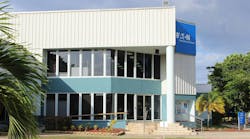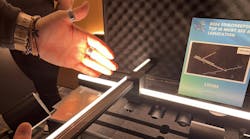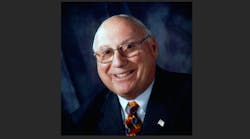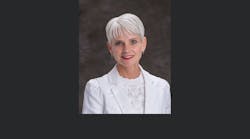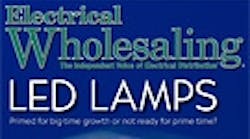Seldom does a new product technology hit the electrical wholesaling industry with as much potential profit — and potential peril — as LED lighting. It's hard to believe that the basic technology powering all those tiny green and red indicator lights in VCRs, computer hard drives, exit signs, traffic signals and car tail lights have the potential to one day revolutionize the lighting world.
That day hasn't come yet industry-wide, but in some specific lighting niches it's right around the corner. The tricky part for electrical distributors, independent manufacturers' reps and lighting manufacturers is figuring out where and when. As with any new technology, most LED manufacturers are doing everything possible to develop the very best products for the market, but you have some rogue companies looking to make a quick buck with inferior products and false marketing claims. More than one lighting professional contacted for this article said the LED market is like the Wild West, and all say it's an exciting time to be in the LED market.
Said David Nelkin, director of product development, Halco Lighting Technologies, Norcross, Ga., “It's a little bit of the Wild West — not a whole lot of standardization yet, and there isn't another product category in all of lighting that has more variance in terms of quality, cost, light output levels and specification details. You will find products rated from 20,000 hours to 100,000 hours made with all of the same components.”
Greg Thorton, president and founder, Environmental Lights, San Diego, Calif., has a unique perspective on LEDs. An electrical engineer, he spent much of his early business career in the semiconductor industry before sensing an opportunity in LED lighting. He sees the parallels with what's happening today in LEDs and the early days of personal computers. “The LED industry today in regards to general illumination is about where the PC industry was in 1986. Back then, monochrome monitors and 5¼ inch floppies were hard to use and the software was buggy. We all knew they weren't really ready for prime time but we were using them anyway because they were better than the alternative.”
Keith Ward has been a “lamp guy” for 30 years and was recently named president and CEO, Luminus Devices, Billerica, Mass., a LED manufacturer. He says being in LED right now is “completely exhilarating.”
“The over-hyping is really about performance of the product versus expectation,” he says. “This is where I believe everyone should be careful. Look for reputable companies with published statistics and performance data, a strong patent portfolio and ensure that the consistency of the performance is maintained over multiple shipments and production lots. There are many exaggerations as to life of the LEDs. Some caution here — think in terms of 50,000 hours or so.”
Lightfair 2009, the lighting industry's annual meeting of the clans, was a good snapshot of the state of affairs with LEDs. Although this year's LightFair was in the heart of Big Apple, it had a Wild West frontier feel to it. Most of the 400-plus exhibitors seemed to have some sort of LED product on display. You had the Big Three lighting manufacturers — GE, Osram Sylvania and Philips Lighting and LED specialist Cree Inc., Raleigh, N.C., with large presences at the show and a heavy focus on LEDs; a few dozen lamp, fixture and controls companies that show up often on distributor line cards; but an enormous number of other players new to U.S. lighting industry, including many component manufacturers from the Pacific Rim, where many mainstream U.S. lighting companies source components.
Cathy Choi, vice president, Bulbrite, Moonachie, N.J., said she met a lot of manufacturers at Lightfair who were into plastics and polymer markets, and were just getting started in the lighting with a new line of LEDs. “They are not lighting people per se,” she says. “You don't know who they are, where they are, where they have been or where they are going. At LightFair this year there were a lot of LEDs showing and a lot of companies probably won't be there in two years — they will have been bought out by someone or lighting isn't their primary market.”
Adding to the controlled chaos at Lightfair 2009 was the diversity of marketing and display tactics. It wasn't uncommon to hear an exhibitor claim his company's LED would last 100,000 hours, but not have any independent testing data to back it up. Down the aisle another LED manufacturer could be heard badmouthing CFLs. Trying to establish some sense of law in the industry is one of the sheriffs — the Department of Energy (DOE) — which has taken a lead role in developing performance standards for LEDs. At the DOE booth at Lightfair, representatives of its Solid-State Lighting program gave seminars on the DOE's certification programs and the widely applauded work it's now doing with lighting manufacturers, trade association allies and other lighting professionals to craft strict testing and performance standards. Jim Brodrick, the DOE's lighting program manager, and his team have a major challenge on their hands, as 50 percent of the LED products they have tested in Round 7 of the DOE Caliper testing program didn't live up to manufacturers' own performance claims. Ouch.
To help readers sort through this glorious mess of opportunity and confusion, Electrical Wholesaling spoke with lighting professionals to develop the following “dos and don'ts” for electrical distributors in the LED market.
Put LEDs in the proper perspective — and application. Yes, LEDs have a ton of potential and are already a cost-effective option in some niches of the lighting market. But they aren't ready for prime time in many general-purpose lighting applications. Tops on the list of real-world applications for LEDs are maintenance-intensive applications that are tough to reach, burn a lot of hours or require a light source with low heat.
At this year's Lightfair, Ray Angelo, president and CEO, Westinghouse Lighting Corp., Philadelphia, and staff spent much of their time listening to customers about potential applications for LEDs. He said the feedback they got at Lightfair confirmed their belief that only a few applications now exist where LEDs are commercially viable. These applications include low-profile garage lighting, tunnel lighting and some parking lot applications. They believe theatrical or architectural applications such as wall washing and outlining buildings are also a natural for LEDs. On a recent trip to Hong Kong, Angelo was impressed with how LEDs are used to highlight skyscrapers.
That being said, Angelo believes state-of-the-art fluorescent lighting technologies for general-lighting applications will be tough to displace. “Lighting changes take a long time,” he says. “There is a huge amount of market share still in T12 fluorescents — one-third to 50 percent of the installed base is still T12s. T8s have improved dramatically and have picked up market share and are a tremendous light source from a cost/value standpoint. That's a hard light source to displace. T5s are a refinement. We like them because of the optics they allow. They do wonders with well-designed reflectors. For most general lighting, I still see linear fluorescent being very formidable. In smaller applications like recessed cans, the U-bends or spiral CFLs are a very viable light source. For our business, which is general lighting, LEDs are going to have to earn their way into the established base.”
Angelo also said it's important for electrical distributors to understand that there's more to LED light sources than just the LED, and that the driver, heat sink, optics — all have to work together to cost-effectively emit quality lighting. “It's a very complex product, he says. “The LED is what is being talked about, but everyone who is knowledgeable about the product knows it's the thermal management, optics, driver and the LED and how they are all integrated.”
Halco's David Nelkin agrees with Angelo that applications where maintenance and replacement costs are high are a good place right now for LEDs. “We try to sell the lamp where labor really makes the payback make sense, where you are using a scissor lift to change a halogen PAR in the ceiling,” he says. “Then a LED might be right for the application. Some of the other applications are where heat and UV become an issue — museums, galleries and any place that has art or jewelry cases. We outfitted Tiffany & Co. in New York with our MR11 LEDs, and they loved them because when they put their hand in jewelry and pick up a ring, it hasn't been sitting under a halogen lamp.”
While most people don't see much yet in residential applications, Greg Thorton of Environmental Lights says in San Diego some wealthy homeowners with 5,000-square-foot homes are upgrading their home lighting with LEDs. But sometimes the initial cost of an LED conversion in these homes — up to $85 to $90 per recessed can in houses that can easily have up to 60 recessed cans — can seem a little pricey even to the wealthy. In these situations, Thorton and his salespeople talk with the homeowners about installing LEDs in the rooms they use most often, with the hopes that the homeowner will upgrade other areas of the house in the future.
Learn the difference between low-power LEDs and high-power LEDs
This is critical to understanding where LEDs fit into the lighting market. According to DOE's website, low-power LEDs are typically 5mm in size, operate at a low voltage (3.2V DC) and produce a small amount of light, perhaps 2 lumens to 4 lumens. High-power LEDs come in 1W to 3W packages driven at much higher current, typically 350 mA, 700 mA, or 1,000 mA. They can produce 40 lumens to 80 lumens per 1W package. Nichia, Cree and Seoul Semiconductor are three of the largest producers of LEDs of both types.
Doug Root, director of sales and marketing, Atlanta Light Bulb Inc., Tucker, Ga., says that while low-power LEDs have their place, particularly in accent lighting applications or as indicator lights, when used in the wrong applications they can give LED lighting a bad name. He is worried that because the first wave of LED products now hitting consumer markets through Wal-Mart and other big-box retailers often utilize low-power LEDs, the poor light quality and short lamp life they may offer will give consumers a bad first experience with LEDs. Root says some of these low-power LEDs are basically “glorified indicator lamps.” He has found a natural application for low-powered LEDs as the red and green indicator lights on automatic teller machines (ATMs), which in the past had been using 150W PAR lamps.
“LEDs have come down to the consumer market so fast,” he says. “It has already become mainstream, but the technology is not even there to be a viable technology. There is a gamut out there from a $2 LED to a $400 LED. What happens is the public buys on price, and they are going to buy the technology that's not the best. It will give LEDs a bad name in the public view, right before it's getting ready to take off.
“You have to always question a customer about what they want to do with the LED. Low-powered LEDs have their place, like in accent lighting. They are not good for general lighting. Some LED manufacturers take about 20 low-power LEDs and a PAR 30 or PAR 38 bulb, take out the insides of the bulb and then put an electronic circuit board down inside of it and hook these LEDs into it. It's just a whole bunch of LEDs stuffed into an envelope that looks like a lamp. They are going to degrade over time. There is no metal in it, so there is no heat sink. High-powered LEDs are really good for certain applications, like open track lighting. Once you enclose a LED you have some heat issues.”
Adds Halco's Nelkin, “The heat causes the diode itself to have accelerated lumen depreciation. The lamp gets dimmer and dimmer. It doesn't actually shut the lamp off unless the heat gets high enough that it affects the driver component. One of the biggest misapplications is in an IC-rated recessed can (rated to come in contact with insulation) that might be designed for filament products or CFLs. It doesn't allow heat out of the top of the can.”
Nelkin agrees that distributors and their customers need to pay attention to the differences between high- and low-power LEDs. “Low-power LEDs are not really intended to provide light — they are indicator lamps,” he says. “They also have accelerated lumen depreciation. What you see when you first light one will be very different from 3,000 to 5,000 hours down the road. That's one of the first distinctions we try to draw.”
Separate the truth from the hype by learning from other lighting product launches
LEDs aren't the first light source with game-breaking potential to capture the imagination of the entire lighting industry. Industry veterans remember the rollout of high-pressure sodium in the 1970s, compact fluorescents in the 1980s and electronic ballasts in the late-1980s/early 1990s. Lessons learned? Change takes time, be ready for some over-the-top hype and brace yourself for some product failures in the early going.
Bill Attardi, president, Attardi Marketing, Colts Neck, N.J., sees some significant parallels between LEDs and the launch of these other products. Now as back then, Attardi says that if electrical distributors want to get serious about LEDs, they will have to create demand for these products and not just satisfy demand. “The first real energy product that came out of the industry was back in the 1970s with the PL lamp, (a plug-in version of the CFL) right after the energy crisis,” he says. “It was such a new technology, and it didn't ‘look good or smell good.' It took too long to start up and the price was way out of line. Even though the story was good because of the life of it and because of the initial cost, it never took off until the last 10 years to 15 years.”
Attardi believes LEDs are a bit over-hyped because they are not ready to replace fluorescent lighting in general lighting applications. “LEDs will serve a purpose for the distributor in the task lighting, accent lighting and aesthetic lighting,” he says. “That will give them a good feel for the product and what it can do. But LEDs are expensive. They do last longer, so it has a good story from that standpoint, but it really doesn't have a better energy story than T8s or CFLs. LEDs have to get to 80 lumens per watt to 100 lumens per watt before it becomes a real serious general-lighting product. Right now it's around 50 lumens per watt or 60 lumens per watt, which is the same as CFLs. And manufacturers have to get the cost down. It doesn't yet compare to a T8 electronic ballast system for general lighting. When they can get it right, it certainly has tremendous potential.”
In a former lighting life, Randy Johnson worked for GE Lighting before buying US Lamp, Inc., Green Bay, Wis., in 1986. He has seen this excitement — and concerns over product quality — before. “T8 fluorescent lamps were introduced in 1982 and electronic ballasts just started coming around in mid-80s,” he says. “There were lots of problems with them. In 1989 to 1991, they took off like wildfire, but the quality was poor. There were only one or two IC chips being used and there were rampant ballast problems. There was the same wave of excitement, but everyone got gun-shy because a lot of people got burned and some people went out of business because they couldn't stand behind the warranties of some of the product that came in from overseas. We were constantly doing group reballasts.”
Johnson's company has been carrying several brands of LEDs for a couple of years now, but overall has found a slow acceptance rate due to the first-cost purchase price. “We have seen the best success in point-source lighting where you are looking at the LED, like in LED exit signs, LED tail lights, signage and traffic signal lighting. They are a no-brainer. The struggle is that everyone is trying to make that quantum leap to general illumination.”
He says the LED replacement products designed to replace 4-foot fluorescent lamps don't “pencil out” when you run a return on investment analysis. “If you take a $2 or $3-dollar 4-ft T8 lamp versus a $75-$100 LED retrofit, even if they function properly, it's upside down economically,” he says. “You never get to break-even because of the first cost. All of the ones we have seen don't produce nearly enough light output to be a representative replacement for a 4-ft T8.”
Bulbrite's Cathy Choi also questions the value of the LED T8s. “The LED T8s don't make a lot of sense to us,” she says. “T5 and T8 fluorescents are highly efficient light sources.”
Garrett Grega, product marketing manager for LED retrofit products, Philips Lighting, Somerset, N.J., believes the excitement generated by LEDs exceeds that of CFLs. “Over the past decade, discussions around CFLs were largely about energy savings and long life,” he says. “However, LEDs deliver even higher efficiency and longer life in addition to a range of other benefits, such as high quality colors, fast response time, and the absence of mercury in the design and UV or IR in the beam. Based on their array of benefits and the expanding range of professional and general applications that they are capable of supporting, there seems to be a great deal more broad-based hype around LEDs than any other lighting technology in recent history.
“A lot of the expectations with LEDs are indeed legitimate, but there are still many products that are claiming more light than they actually produce,” Grega says. “The R&D cycle for LEDs is creating products that are just now hitting incandescent equivalency points. For lighting designers, specifiers and sales channel members, it's important to understand the true light generated by an LED and to question and test the products to get those answers.”
A GE spokesperson says the expectations and excitement around LEDs is larger than any other lighting technology to hit the industry, and for good reason. “High-efficiency LEDs, when designed correctly into a properly functioning system, can provide many end user benefits including energy savings, maintenance savings, environmentally conscious, improved lighting design, and reduced fading/spoilage of displayed merchandise or art,” he said. “LED technology for general lighting is still at its infancy and currently has some challenges including many unproven startup companies entering the market; high variability from system to system; color consistency; cost compared to today's efficient light sources (such as energy-saving T8s and T5s); high cost of white light; thermal management; confusion over evolving standards; and inflated performance claims.”
Susan Isenhour Anderson, manager of energy relations for Osram Sylvania, Danvers, Mass., says the last time the lighting industry had anything close to this excitement level was when energy saving T12 systems were introduced during the oil embargo of the 1970s. She says some of the overhype in today's LED market is really more a lack of understanding about the difference between what is achievable with LEDs in the lab and how they perform in real-world conditions.
“LEDs certainly offer us great potential to reduce energy use for lighting and are ready for the marketplace for several applications,” she says. “My fear is that they will be shoved into luminaires designed for other technologies that are not appropriately designed for LEDs. If this happens, end users will have some of the same bad experiences that early adopters of CFLs had. The sad truth is that based on testing being done by Rensselaer Polytechnic Institute's Lighting Research Center this is already happening. LEDs need to be used in luminaires designed with the appropriate optics and thermal considerations to allow LEDs to deliver the performances that justify their use — both in terms of efficiency and life. It will help that EnergyStar is getting involved now to set standards for retrofit lamps and luminaires.”
Keith Ward of Luminus Devices sees some similarities in the launch of CFLs and T5 and metal-halide, but says the impact of LED will be greater than all combined. Over time he thinks LEDs can be a “global lighting category killer or change agent” because they integrate into so many applications. “DOE's efficiency roadmap projects LED white efficiency to exceed 180 lumens per watt by 2012,” he says.
Keep up with DOE's Caliper testing
All lighting executives interviewed for this article agreed about the importance of the DOE Caliper testing and said electrical distributors should frequently check the DOE site at www1.eere.energy.gov/buildings/ssl/caliper.html for status updates on manufacturers' LED products. The Caliper program guides the development, refinement and adoption of credible, standardized test procedures and measurements for SSL products and provides objective LED product performance information so that buyers and specifiers have confidence that new solid-state lighting (SSL) products will perform as claimed.
There's been a lot of chatter in lighting circles lately about the poor performance of screw-in LED replacements in the Caliper testing. Jim Brodrick, DOE's Solid-State Lighting program manager, says in the past their performance had been low, but that some soon-to-be released test results show improvement. “We have been testing these in the Caliper program and the general history over the past year is they have not been very good,” he says. “They have been very efficient, but the amount of light coming out of them is low. This time around we hit a couple that are very good. Caliper Round 8 will be out in the first two weeks in July.”
Study the winners of the DOE lighting design competitions
Another great resource at the DOE website for lighting professionals is the information on the solid-state lighting design competitions that DOE co-sponsors with other industry partners. There are so many new LED products hitting the market each month that it's tough to pick the best of bunch. DOE's Brodrick says electrical distributors can use the Lighting for Tomorrow (www.lightingfortomorrow.com) and Next Generation Luminaires (www.ngldc.org) design competitions to screen products and narrow down potential vendors. Winning products have undergone a rigorous evaluation process by lighting professionals. “If distributors are interested in stocking LEDs, a lot of the screening has been done for them,” says Brodrick.
Top winners in the 2008 Next Generation Luminaires competition were GE's Immersion product for jewelry case lighting; Journee Lighting's Azara track-mounted luminaire; and Winona Lighting's Step03 indoor/outdoor step lighting. Brodrick also urges distributors to look for LED products with the EnergyStar label. “People are getting quite excited about it and we want to steer them toward the better products,” he says.
Summary
The LED market is expected take huge strides over the next few years. Greg Thorton of Environmental Lights says the industry is growing 40 percent a year for general illumination and that according to Haitz's Law (similar to how Moore's Law measures and predicts the continual increase in computing power), the efficacy of LEDs doubles every 18 months. “We are living it,” he says, “Every trade show we see dramatically better product. The thing that I worry about the most is this industry is going to grow in a messy fashion. Your readers are going to buy this stuff and some of it will fail in the field, and some won't last as long as it is supposed to.”
Bill Attardi, Attardi Marketing, says there are more external influences driving demand for energy-efficient lighting technologies like LEDs than ever before. “President Obama has made it very clear that the three major issues he is going address are education, health and energy. We have never had that kind of focus on the part of the government, especially in a down economy. The stimulus plan is allowing investment in these kinds of technologies.”
Philips Lighting's Grega says this is an exciting time in the lighting industry. “LEDs are at their infancy, but they are fast becoming a part of our long-term solutions to energy efficiency and environmental sustainability,” he says. “It will clearly benefit distributors to familiarize themselves with the features, functions and benefits of this high-performing and rapidly-expanding technology.”
Quick Tips for Selling LEDs
Test LEDs before you sell them
Experiment with new LEDs lamps before taking on the line.
Don't always believe the crazy talk on lamp life
If some supplier you have never heard of tells you his lamps last 100,000 hours, ask to see photometric reports from an independent testing agency. Check all manufacturers' claims against data on the DOE website.
Look for the EnergyStar label
An LED product that earns the EnergyStar designation has passed some stringent testing. Not all LED categories are covered yet, but more are coming online this year, including LED screw-in replacement lamps.
Start small
Even selling a LED flashlight can start the conversation on where LEDs may work for customers in other locations, says Cathy Choi, vice president, Bulbrite, Moonachie, N.J.
Educate the counter staff
Choi says the folks behind the counter are the ones who will get the questions about the differences between the LED lamps you sell and the cheaper LEDs they can buy at Home Depot or Costco.
Recommend LEDs in low light-level, tough-to-access or 24/7 applications
Garrett Grega, product marketing manager for LED retrofit products, Philips Lighting, Somerset, N.J., says examples include accent and decorative locations that don't require much light and lobbies and corridors with 24/7 light requirements. Applications in hard-to-reach or maintain locations such as over escalators or high ceilings are opportunities for LEDs, he says.
Questions You Need to ask Vendors about LEDs
To assist attendees at the 2009 Lightfair, DOE Lighting Program Manager James Brodrick put together a product evaluation checklist. Since the show, he added additional material from product selection tips offered by Jeff Quinlan of Acuity Brands Lighting, Tim O'Sullivan of Cree and Avi Mor of Lightswitch Architectural at a recent DOE workshop. Electrical distributors and reps should use these questions to evaluate potential LED suppliers.
Input/Output
-
What are the delivered lumens?
-
What is the real input power?
-
Do you have LM-79 photometric reports and IES files from an independent testing lab?
Color
-
What is the CRI at each color temperature?
-
How do you ensure color consistency among fixtures built today or a year from now? Over the life of a product?
-
Does the thermal management system keep the LED junction temperature below specified maximums in all applications?
-
May I see at least two samples of the same Correlated Color Temperature?
-
Were your chromaticity measurements performed according to LM-79 by an independent lab?
-
Is there a written binning policy?
Life/Warranty
-
Is there a written end of life policy? How will spares be made available?
-
Do all system components from SSL manufacture have a warranty and labor to fix/replace?
-
How long is the warranty? What exactly is covered?
-
Has LM-80 testing been performed by your LED or LED module manufacturer? What does it say about lumen maintenance?
Other
-
Is the product EnergyStar qualified?
-
Whose LEDs are being utilized?
-
Is the product listed to a UL standard? (UL1993 for self-ballasted lamps, UL1598 for fixtures)
